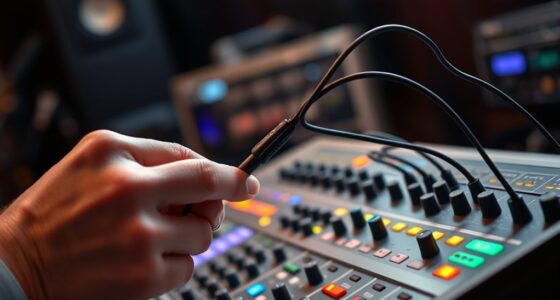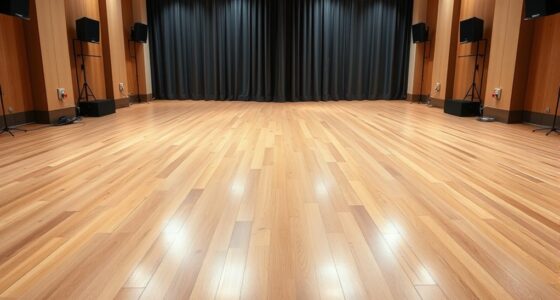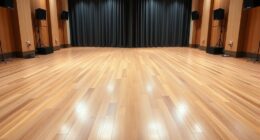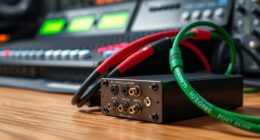Using pad and key splits in live playing lets you switch sounds quickly and create layered textures effortlessly. You can assign different sounds to specific zones, enabling smooth progressions and a more dynamic performance. Layering multiple voices within zones adds depth, while managing frequency overlaps keeps your mix clear. Experiment with zone setups, voicing, and EQ to enhance your soundscape—continue exploring these techniques to craft more engaging performances.
Key Takeaways
- Use pad and key splits to seamlessly switch sounds and sections, maintaining performance flow without interruptions.
- Assign different sounds to specific zones for versatile live arrangements and dynamic texture layering.
- Layer multiple sounds within split zones, adjusting voicing and parameters for clarity and richness.
- Manage sound interaction with EQ, filtering, and slight detuning to ensure clear separation during performance.
- Create expressive soundscapes by using zone switching and layering to craft evolving textures and emotional transitions.

When performing live, using pad and key splits allows you to seamlessly switch between different sounds and musical sections, keeping your performance dynamic and engaging. This technique is essential for musicians who want to maintain fluidity without constantly fumbling with settings or stopping to change instruments. By dividing your keyboard into multiple zones, you can assign distinct sounds—like a lush pad on one side and a sharp lead on the other—so that you can transition smoothly from one musical idea to another. This approach not only enriches your performance but also offers creative freedom to explore complex arrangements on the fly.
A vital aspect of effective key splits is mastering synth layering and voicing techniques. Synth layering involves stacking multiple sounds to create a richer, more textured tone, which can be particularly useful when performing with split zones. For example, you might layer a warm pad sound with a subtle string or choir element to add depth, then assign this layered sound to a specific split zone. This ensures that each section of your performance has a full, immersive character. Voicing techniques come into play when you want to control how these layered sounds interact. By adjusting parameters like octave shifts, detuning, or stereo spread, you can enhance the clarity and separation between your split zones, making each sound distinct despite overlapping frequencies.
Additionally, voicing techniques help you prevent muddiness or frequency clashes during live play. When you assign multiple sounds to different zones, it’s important to consider their harmonic content and how they sit together. Using techniques like EQ adjustments, filtering, or even slight pitch differences can help each sound occupy its own space, making your performance cleaner and more professional. For example, when splitting a bass line from a melodic lead, you might slightly detune one to add richness or use a high-pass filter on the pad to keep it from masking the more prominent sounds.
Furthermore, understanding how to utilize synth layering and voicing techniques in conjunction with pad and key splits allows you to craft more expressive performances. You can create dynamic swells, layered textures, or evolving soundscapes that change as you move across zones. This not only keeps your audience engaged but also gives you greater control over the emotional impact of your music. When you master these tools, your live setup becomes a versatile palette of sounds that you can shape creatively in real-time, elevating your performance from simple playing to a captivating sonic journey. Additionally, paying attention to the contrast ratio of your sounds can help you achieve clearer separation and more impactful transitions during your set.
Frequently Asked Questions
Can Pad and Key Splits Be Used Simultaneously?
Yes, you can use pad and key splits simultaneously. This allows you to apply layering techniques, where pads can add texture while key splits trigger different sounds on the keyboard. You can customize splits to suit your performance, combining both for a dynamic setup. By leveraging split customization, you can seamlessly switch between or combine pads and keys, enhancing your live playing experience with more expressive and versatile sound control.
What Equipment Is Best for Live Pad and Key Splits?
You need the best equipment to master live pad and key splits, and it’s like having a musical superhero at your fingertips! Go for a MIDI controller with advanced sound layering and customizable MIDI mapping, such as the Ableton Push or Native Instruments Komplete Kontrol. These tools let you switch effortlessly between splits and layers, giving you full control. With this gear, your performance will be unstoppable and infinitely creative!
How Do I Troubleshoot Split Conflicts During Performance?
When troubleshooting split conflicts during performance, start by checking your MIDI mapping to make certain each split area is correctly assigned. Use split customization to adjust boundaries or merge conflicting zones. Verify your controller’s settings and firmware are up-to-date. If conflicts persist, reset your MIDI mappings and reconfigure splits carefully, testing each change live. This helps you identify and resolve issues quickly, keeping your performance seamless.
Are There Tutorials for Programming Custom Splits?
Did you know that nearly 60% of performers customize their splits for complex live setups? You can find great programming tutorials online that guide you through split customization, helping you craft perfect splits for your performance. These tutorials walk you through programming custom splits step-by-step, so you can confidently set up your instrument for seamless transitions and unique sound arrangements. Immerse yourself in these resources to elevate your live playing experience.
How Do Splits Affect Overall Sound Quality?
Splits can impact your overall sound quality by causing sound degradation and affecting signal integrity. When you create splits, the signal divides, which may weaken the audio or introduce noise if your equipment isn’t designed for it. To maintain quality, use high-quality gear and proper gain staging. This way, you preserve clarity, avoid unwanted noise, and guarantee your splits sound as good as the original signal during live performances.
Conclusion
Mastering pad and key splits transforms your live performance into an unstoppable musical juggernaut. With these techniques, you’ll wield your keyboard like a superhero’s power, effortlessly captivating every audience member in the stadium-sized crowd. No challenge is too great, no shift too tricky—your setup becomes an unstoppable force of sonic brilliance. Get ready to blow minds and leave everyone in awe, because once you open these splits, you’re not just playing—you’re conquering the stage like a legendary legend!









